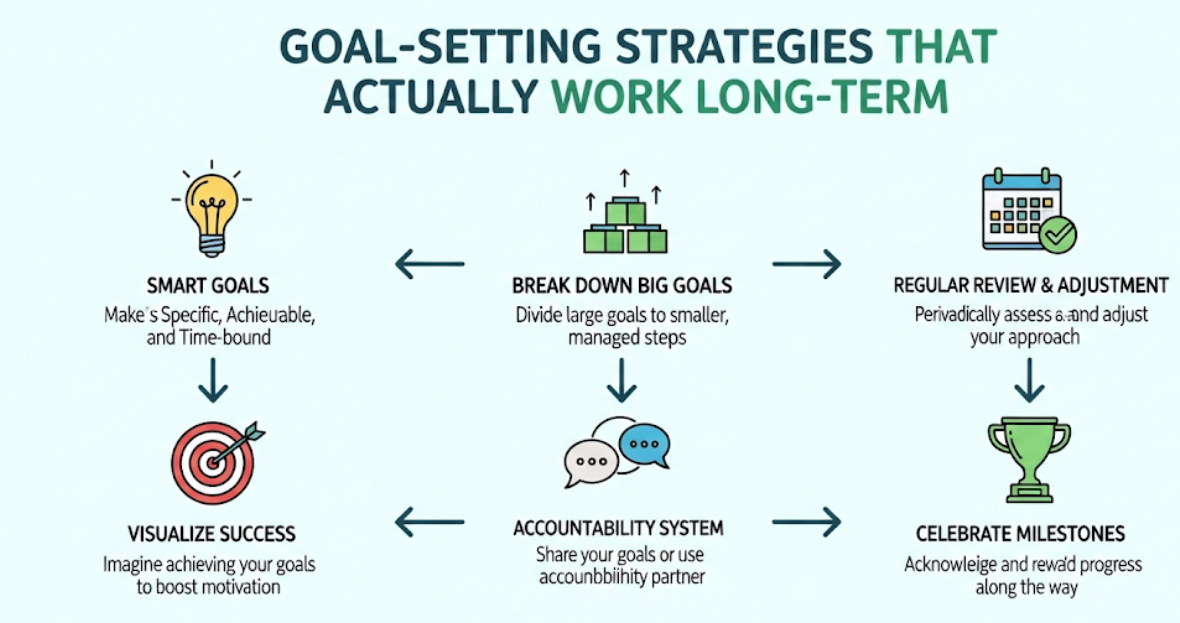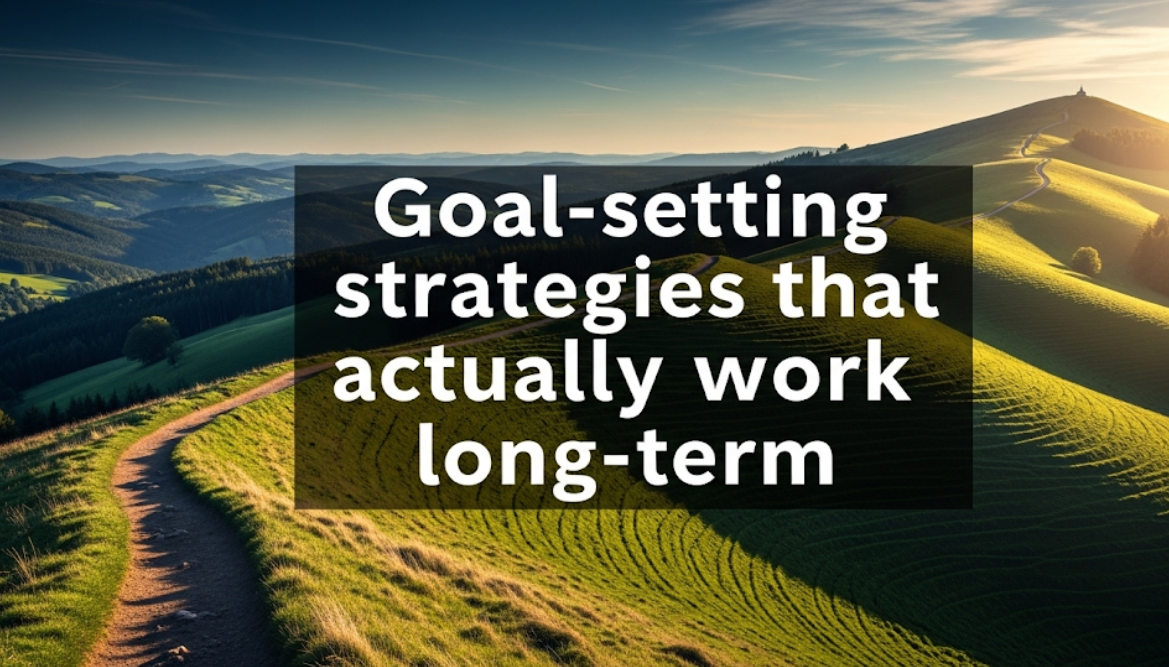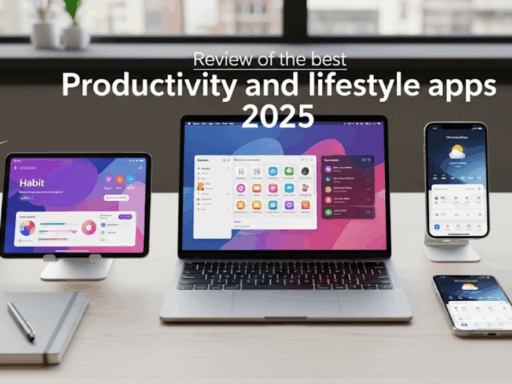Practical (Beyond SMART) Goal-Setting Techniques
Setting goals is easy. Achieving them? That’s where most people struggle. Only 8 percent of people achieve their New Year’s resolutions, as reported by studies — patterns hold true generally for any type of goal-setting. The issue is not about being motivated… the problem lies within the strategies that sound really great on paper but would never work in real world.
If you have ever felt exhausted at peering over your disappearing goals when the feeling of inertia sets in again after a couple of weeks, then help is here! Fortunately, research has determined strategies that result in long-term success. This is not about tips or motivational hacks. These are battle-tested strategies that work when life gets hard, motivation fades, and obstacles arrive.
In this post, I will help identify the right goal-setting strategies that successful people use to bring their future into existence. I am going to share why most things you have tried are not working, what it really takes, and how to create a system that will break the success cycle.
Why Traditional Goal-Setting Methods Fail
But before we get into what does work, most frameworks for setting goals you might have tried up until now, don’t hold results. It’s just that so many of us have a knee-jerk reaction to failing at our goals, deciding it’s actually the fault of us as people and not in any way, shape, or form a problem with the structure and system we were using.
The Motivation Trap
Nearly all goal-setting advice assumes you are always motivated. It is dependent on determination and motivation to drive you. But motivation naturally fluctuates. January 1st is when you feel motivated about your fitness goals, but by February this has died down and old habits have returned.
According to Stanford University research, that plan is a terrible idea as motivation only will result in a 92% failure rate. Long-term, the ones who succeed do not rely on motivation to feel motivated; they control it with systems that work.
Vague Goals Create Vague Results
I mean, things like “I want to get fit” or “I want to save money” aren’t really goals — they’re wishes. Your brain has no idea what to focus on without specific targets and clear action steps. Labeling things like this makes it extremely hard to track progress because you never know when you are actually done or succeeded.
The All-or-Nothing Mindset
Traditional goal-setting often leads to an all-or-nothing behavior. Skip one workout and all of sudden you have thrown in the towel completely. Avoid doing your new habit one day and it almost seems easier to ditch the whole thing. This perfectionistic mentality has probably murdered more goals in cold blood than all external obstacles combined.
Ignoring Your Environment
However, most goal-setting processes only ask about what you want, not the environment that will support (or sabotage) your success. Your environment, your relationships, and your routines are essential to whether or not you’ll succeed — but they aren’t typically part of the plan!
The Psychology of Achieving Your Long-Term Goals
Goal Setting is not only selecting targets, it is also working with your brain — using its structure and functions. When you want to increase your odds of lasting success, it is prudent to create any personal development strategy based on psychological theories of learning.
Identity-Based Goals vs. Outcome-Based Goals
The average person goes about goal setting backwards; they set outcome-based goals like “I will lose 20 pounds” or “I will save $10,000.” However, the research makes it pretty clear that identity-based goals are much stronger: “I want to be someone who cares about my health” or “I want to be someone who is financially responsible.”
When we focus on identity, every little thing done is proof of who you are becoming. Instead of feeling that you are obliging yourself and doing things that you think should be good, you act in congruence with who you truly are.
The Compound Effect of Achieving Your Goals
Large results are created from small actions repeated over time. You get 37X better over a year at just a 1% improvement every day. This principle works because:
- Tiny adjustments are more likely to stick
- They build momentum gradually
- Your brain does not resist them
- They create positive feedback loops
Dopamine and Goal Achievement
Rather, when you merely anticipate a reward, your brain releases dopamine. So you can game the system by celebrating every little win that comes your way. It produces dopamine with each small victory that motivates you to keep going.
What makes the difference is you creating multiple opportunities for small wins as opposed to thinking there will just be one and it better come at the very end.
Beyond the New Year’s Resolution: The SMART-ER Framework
While you’ve heard of SMART goals (Specific, Measurable, Achievable, Relevant, Time-bound), the rockstars in their respective fields follow an improved version called SMART-ER that introduces two important components — Evaluate and Readjust.
Specific: Crystal Clear Targets
Vague goal: “Exercise more” → Specific goal: Walk for at least 30 minutes on Tuesdays, Thursdays, and Saturday mornings. The more detailed and specific your goal, the simpler it is for the brain to craft an action plan.
Examples of specific goals:
- Read 24 books (so an average of 2 a month)
- Save $5,000 by December 31st ($417/month)
- Practice Duolingo for 20 minutes daily and learn conversational Spanish
Measurable: Track What Matters
How else will you know if you are getting anywhere unless your metrics are clear. But watch out—measure the right things. In addition to measuring outcomes (how many pounds you lose), also measure your inputs (how many workouts you complete, how many healthy meals you eat).
Effective measurement strategies:
- Lead with both leading indicators (what you do) and lagging indicators (what you get)
- Track weekly instead of daily
- Look at consistency percentages (Did it 5 of 7 days = 71%)
Achievable: Stretch But Don’t Snap
Your goals should be audacious, but not outrageous. General tip: go for around 60-70% of what you feel capable of doing. Too easy and you won’t grow. Any harder and you’ll be disheartened (and wasting your time).
Relevant: Align With Your Values
It will be easier for you to make goals that are aligned with your values and stick with them. Question: Why Does This Goal Matter? If you can’t think of a strong reply, perhaps decide on a different goal.
Time-Bound: Create Urgency
Deadlines create focus and urgency. Turn that into a series of tiny deadlines rather than one big deadline. It keeps momentum and you get to celebrate progress all the time.
Evaluate: Regular Check-Ins
Set these up on a weekly basis to see how you are progressing. Ask:
- What’s working well?
- What’s not working?
- What obstacles came up?
- How can I adjust my approach?
Readjust: Flexibility Leads to Success
Keep the target of your goal steadfast in your heart. When your current method is failing, change everything except the direction.
Systems First for Goal Achievement
Goals are about where you want to go and what you want to achieve. Yet systems are all about those processes that get us the results. Goals are good for setting a direction, but provide little guidance on how to actually get there.
Building Your Success System
A good system consists of four main parts:
CUES: Environmental cues that trigger the desired behavior.
ROUTINE: Small, repeatable activities that advance you towards your goal
REWARDS: Minor rewards that keep the behavior going
REVIEW: A routine check-up to maintain the system
The Power of Atomic Habits
The concept of Atomic Habits by James Clear signifies that small things add up to huge results. The secret is creating habits that are so tiny it becomes impossible to fail:
- Want to read more? Start with one page per day
- Want to exercise regularly? Start with one push-up
- Want to meditate? Start with one minute
It grows your confidence, it starts momentum moving in the right direction, and it is infinitely easier to make more sustainable habit changes.
Environment Design for Goal Success
It is important to remember that your environment will have a much greater effect on your actions than sheer willpower. Change your environment: set things up so it is easy to do the right thing and hard to do wrong.
For fitness goals:
- Keep workout clothes visible
- Take junk food away from easy accessibility
- Sign up for a gym that is on your way to work
For learning goals:
- Keep books on your nightstand
- Download educational podcasts
- Disable notifications while studying
For financial goals:
- Automate savings transfers
- Delete shopping apps from your phone
- Use cash for discretionary spending
How to Break Down Your Big Goals into Small Steps
Big goals are intimidating and therefore, they stop us from even starting to take action. The answer is to divide big goals into smaller elements of work.
The 90-Day Sprint Method
Stop the yearly goals, and work in 90-day sprints. This timeframe is:
- Long enough to make significant progress
- Short enough to maintain focus and urgency
- Aligned to natural quarterly business rhythms
How to outline a 90-day sprint:
- Month 1: Laying the foundation and forming the habits
- Month 2: Building momentum & skills
- Month 3: Pushing hard and achieving the goal
Weekly Planning for Daily Success
Take your 90-day goals, break them down into weekly objectives and plan specific daily activities to support the desired outcomes.
| Week | Aims | Daily Actions | Success Criteria |
|---|---|---|---|
| 1–2 | Create Foundation | 30 min morning routine | Done 5/7 days |
| Daily journaling | Done 6/7 days | ||
| Create calendar | Finished 5/7 days | ||
| 3–4 | Increase Intensity | Additional evening review | Finished all |
The Two-Minute Rule
If any step in your process takes more than two minutes, break it down again. Productivity expert David Allen has a great tip for this and it involves the “2-minute rule.”
Examples:
- Write a book → Write for 30 minutes → Open writing document and write one sentence
- “Learn Spanish” → “Study Spanish” → “Open Duolingo app”
- “Organize house” → “File papers” → “Put away 5 things”
Creating Accountability Systems That Work
The odds of you hitting your goals becomes much higher with accountability. According to Harvard Business School research, people who share their goals with someone else are 65% more likely to attain them. Add regular check-ins and that number leaps to 95%.
Types of Accountability Partners
Achievement Partner — Someone working towards similar goals who can relate to your struggles and provide moral support as well as offer guidance.
Support Partner — People in real life, like a friend or your family who may or may not know anything about what you are trying to accomplish, but they love and support you no matter what.
Expertise Partner — A coach, mentor or someone who has done it before that can help you stay on a path and not let you off the hook.
Mastermind Group — A group of people wanting similar outcomes that meet on a regular basis to talk about progress and challenges within the community.
Setting Up Effective Accountability
Weekly Check-Ins:
- Share what you accomplished
- Discuss challenges you faced
- Share specific goals for the coming week
- Ask for help or advice
Progress Tracking:
- Use shared documents or apps
- Send weekly photos or updates
- Create friendly competitions
- Celebrate wins together
Consequence Systems:
- If goal not met, donate to a cause you hate
- Give up something you enjoy for a week
- Do extra work for your accountability partner
- Publicly share your wins (or losses)
Overcoming Common Goal-Setting Obstacles
Every goal-setter faces obstacles. The key to success is not avoiding obstacles but being ready for them and having tactics in your arsenal that can make you overcome them.
The Motivation Dip
The Issue: Motivation drastically dwindles after the initial excitement and novelty wear off (usually within 2–4 weeks).
The Solution:
- Create systems that don’t require motivation
- Put your goal activities on a calendar and treat them as you would meetings
- Focus on identity (“I’m the kind of person that…”)
- Remember your “why” when things start getting hard
The Perfectionism Trap
The Issue: One day is missed or one mistake occurs and it feels like everything failed.
The Solution:
- Use the “never miss twice” rule
- Failures are part of the process. Plan for them!
- Measure consistency, not perfection
- Practice self-compassion
The Plateau Effect
The Issue: Progress either slows drastically or halts altogether, leading to frustration and ultimately quitting.
The Solution:
- Appreciate the plateaus as a part of growing
- Simply switch up your methods – while keeping your goal
- Understand that change happens in phases
- Ask a more experienced person for help
Social Pressure and Lack of Support
The Issue: You have no support from friends or family, and actively get discouraged by others.
The Solution:
- Join communities that share your goals
- Set boundaries on negative influences during goal pursuit
- Communicate clearly about your priorities
- Always focus on your progress, not the negative opinions of others
Tracking Progress Without Obsessing
There is no way to know if you are on the right path, but you may become obsessed with extreme tracking of every detail. The trick is getting the balance right.
The Minimum Effective Tracking
Keep track of as few metrics as possible that provide usable feedback.
- Fitness goals to track: workouts completed, not every calorie or step
- Learning goals to track: time spent practicing, not every page read
- Money goals to track: money saved, not every expense
Weekly vs. Daily Tracking
Daily tracking could easily be stressful and time-wasting. If you are going to track, do it weekly: ideal feedback, less of a head game.
Designate A Single Weekly Review Day:
- Look at trends, not single days
- Celebrate weekly wins
- Plan strategies according to the weekly routine
The Three-Color System
Use a basic three-color approach to monitor progress:
- Green: Exceeded expectations
- Yellow: Met minimum requirements
- Red: Fell short of minimum
This system offers immediate visual feedback without the need for complex calculations or extensive analysis.
Progress Photos and Journaling
Numbers don’t tell the whole story. Consider these additional tracking methods:
Progress Photos:
- Weekly photos in the same position
- Observe differences in posture, attitude and energy levels
- Compare monthly rather than weekly
Goal Journaling:
- Weekly reflections on struggles and celebrations
- Document lessons learned and insights gained
- Track mindset and motivation changes

Adjusting Goals Without Giving Up
Flexibility is key when it comes to reaching long-term goals. Life moves on and things change; sometimes you need to adjust your approach. The key is continuing to pivot while maintaining momentum.
When to Adjust Your Goals
Adjust when:
- Your circumstances have significantly changed
- You got new information about your goal
- Your values or priorities have changed
- You have tried and failed multiple times with your current method
Don’t adjust when:
- You’re struggling with typical challenges or barriers
- You’re feeling temporarily unmotivated
- You’re making slow progress, but it is progress
- Others are criticizing you where the goal matters
How to Adjust Effectively
Same destination, different path: Keep the same outcome while altering your approach. If you want to be fitter, but the gym is just not happening, then try working out at home, hiking or playing some type of sport.
Change timeline, not ambition: Sometimes goals will take a little bit longer than we thought. Sometimes, it is better (and faster) to extend your timeline than to lower your standards.
Make one change at a time: Do not change the whole strategy at once. When you do make that change, however, make one change at a time and test the results.
Document your reasons: Write down why the changes you are making are necessary. This helps you learn from your own experience and avoid the same issue happening in the future.
Creating Mental Resilience for Sustainable Progress
So much of goal achievement is a psychological game, not just strategy and systems. Developing mental toughness allows you to stick with your goals and stay motivated during times of distress.
Developing a Growth Mindset
Individuals with growth mindsets think of abilities as something that can be developed through effort and strategy. This mindset will help you achieve long-term goals as:
- Setbacks become learning opportunities
- Challenges become chances to improve
- Effort becomes a route to mastery
- Criticism becomes useful feedback
How to create a growth mindset:
- Change “I can’t do this” to “I can’t do this YET!”
- Focus on the process of learning, not just outcomes
- Praise effort and development, not just results
- Study successful people in your field – what do they do?
The Power of Visualization
Mental rehearsal is a powerful technique that works in nearly every domain. Take 5-10 minutes every day to mentally rehearse yourself doing what it takes to get the result that you want.
Effective visualization includes:
- Seeing yourself taking action
- Feeling the emotions of success
- Handling potential obstacles calmly
- Enjoying the journey, not just the destination
Managing Stress and Pressure
Any goal that you pursue can provide quite a bit of stress, particularly if you are invested in the success of your accomplishments. The key to long-term success is being able to manage this stress.
Stress management strategies:
- Regular exercise and adequate sleep
- Mindfulness or meditation practice
- Time in nature
- Talking with encouraging friends or mentors
- Staying focused on what really matters
Creating Your Personal Goal-Setting Blueprint
Now that you know the strategies that work, it’s time to build your personal system. Here’s a 5-step blueprint to achieve any goal (health, career, relationship, personal growth).
Step 1: Choose Your Focus
Instead of attempting to do all-the-things at once, pick 1–3 main goals for the next 90 days. Research shows that the fewer goals you pursue, the better your chances of success.
Goal selection criteria:
- Aligns with your core values
- Excites and motivates you
- Has clear success metrics
- Challenges you without being overwhelming
Step 2: Design Your System
Create a structure for every goal:
- Daily Actions: How will you act each day?
- Weekly Reviews: When will you evaluate performance?
- Monthly Adjustments: How will you tweak your strategy?
- Environmental Changes: What changes will help promote success?
Step 3: Build Your Support Network
Find your supporters – the people who will help you win:
- Accountability partner for weekly check-ins
- Mentor or coach for guidance
- Community of like-minded people
- Family support system
Step 4: Plan for Obstacles
Plan your response by envisioning the three most likely obstacles you will encounter.
Common obstacles and solutions:
- Low motivation: Pre-planned minimal actions
- Time constraints: Priority-based scheduling
- Social pressure: Clear communication and boundaries
- Perfectionism: Self-compassion and flexibility
Step 5: Set Up Tracking Systems
Design easy-to-implement, sustainable progress monitoring systems:
- Track 1–2 key metrics per goal
- Choose apps, journals, or spreadsheets that you actually like and will use
- Schedule weekly review sessions
- Plan monthly progress celebrations
Long-Term Maintenance and Continuous Growth
Achieving the goal is only the beginning. Staying there and continuing to grow is the real challenge.
The Habit Maintenance Phase
Once you have achieved your goal, the focus changes from achievement to maintenance.
Maintenance strategies:
- Reduce intensity but maintain consistency
- Focus on identity reinforcement
- Continue tracking at reduced frequency
- Stay connected with your support community
Setting Your Next Goal
Success should be used as a stepping stone to the next challenge:
Progressive goal-setting:
- Build on what worked
- Choose goals that utilize your new skills
- Increase difficulty gradually
- Keep your winning habits while adding new ones
Becoming a Goal-Achievement Expert
These strategies turn you into the person who consistently achieves almost any goal. This knowledge is no longer something that you know; it becomes a part of who you are, and touches every corner of your life.
Signs of goal-achievement mastery:
- You think in systems as opposed to just outcomes
- Obstacles become problem-solving opportunities
- You help others in the achievement of their goals
- Achieving goals feels easy and natural
Conclusion: Your Blueprint for Lifelong Success
What sets achievers apart is not talent, luck or circumstances. It is their approach to goal-setting and the systems they build. The strategies in this guide are not theoretical – they come from research and have been proven by successful people time and again.
Keep in mind that success is a skill that can be learned, developed and refined through intentional practice. It may not happen the first time, and that’s fine. With each goal you pursue, the more you learn what actually works for you as an individual. The key is to begin, continue and refine along the way.
The single biggest takeaway from this guide: Sustainable success is built on creating systems, not just setting goals. Create the right environment and daily habits so that you naturally reach your goals because of who you have become in the process.
Your goals are calling. You have the strategies, tools, and knowledge to reach them. Which goal will be next to cross off your list?
Start small, stay consistent, and trust the process. Someday in the future, you are going to thank yourself for taking action today.




